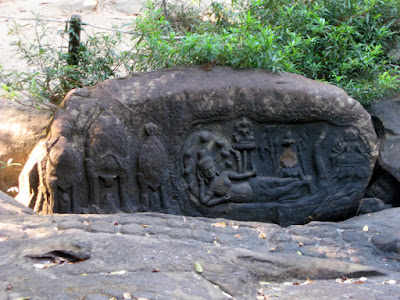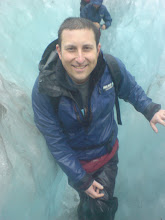It would be impossible to cover everything here. I've taken about 1100 photos in the last four days (although I've deleted 117 today - rubbish ones or duplicates).
It's amazing just how much was built here, mostly between the 10th and 12th Century. In fact, in the city of Angkor Thom - the then capital city - it's estimated that there were 1 million people living there during this time. Incredible when compared with London - which it is estimated had a total population of 50,000.
It must have been an incredible sight - particularly as the temples and structures would have been totally new - and must have been something to see. But empires come, and empires go - but what's left of this one is definitely worth seeing.
In addition to the sun set trip in my last post - I spent three full days looking at the ruins. And while I enjoyed every minute, that was just the right amount for me - any more and it would have been ruined (sorry - couldn't resist a Claytonator).
So here's what happened during the three days:
Day 1: A trip out to see two of the remote temples Kbal Spean, Banteay Srei, and then back via the Cambodia Land Mine Museum. After lunch, it was off to see the Roulous Group - the oldest structures, and the original capital.
Day 2: The Small Circuit today, covering the big hitters, including Banteay Srei, Angkor Thom, and after lunch Angkor Wat.
Day 3: The Big Circuit, including Prea Khan, Preah Neak Poan, Ta Som, Eastern Mebon, and Pre Rup. Today also covered some of the smaller places not covered on day 2. The day finished with a trip out to the floating villages on lake Tonle Sap.
And today - which is a rest day:-)
I decided to go by Tuk Tuk, and was lucky to be able to go with Raman, who made sure I saw everything of importance, and gave me some of the background history. We also stopped for cold drink and chat breaks along the way - which really broke up the day.
I'd recommend going by Tuk Tuk, because you won't see as much by bike or foot - it gets extremely hot, and it's also very humid - and it can be quite hard work just looking around. It's also more comfortable than sitting on the back of a moto.
What I've picked out are the highlights - which has been hard. I've also included links for anyone interested in reading more. What follows is a flavor (Fresh, Fresh, Flavor):
Kbal Spean
The famous "Valley Of A Thousand Lingas, a carved riverbed set amidst beautiful forest, including representations of Vishnu and Shiva, along with (you guessed it) 1000 (or maybe more) lingas and Yoni designs - all from Hindu Mythology.
What exactly the Linga and Yoni are is open to some debate. What is known is that the Linga is connected with the worship of Shiva. But plenty of people will also tell you that it and the associated Yoni are Phallic symbols - and it's easy to see (from some of the pictures below) why this is the case.
There's no doubt in the mind of the people here - they'll tell you that: "The Linga is the man, and the Yoni represents the woman" along with a knowing smile and nod of the head - say no more.
They also say that one of the symbolic uses of these images is to pour water over the two images and that the water is then drunk to bring fertility. And some people actually do come here to drink from the waterfall.
Either way - it's a nice place to spend an hour or two.
Shiva carving in the rock - part of it was hacked off and stolen - the repair job is pretty good:

Linga and Yoni Design:

And some more:

And yet more:

The "Fertility" Waterfall - the water actually tasted OK - even though it was brown:

Banteay Srei
A small temple in comparison to the rest - but the art work here is incredible. Some of the best carvings in the world are at this temple, and the art work is remarkable. Even more so, given that it was carved in the 10th Century.
Carved Lintel and Door Frame:



The library:

View from the moat:

The Cambodian Land Mine Museum
Not a particularly enjoyable place to visit in the traditional sense - but well worth going to see. Conservative estimates put the number of land mines and unexploded ordance (UXO's) currently in Cambodia at between 3 and 6 million. While there are teams working to remove this curse, it will take many years, and deaths and injuries from UXO's happen on a disturbingly frequent basis.
Children are sadly often the main victims, and the organization runs an orphanage on site.
If you'd like to lean more, please see there site: http://www.cambodialandminemuseum.org/, where it's also possible to make a donation to the work.
Angkor Thom
The capital city of the Khmer Empire - a 9 kilometer square expanse, surrounded by walls, within which many temples were built.
There's lots to see here, but the highlight for me was Bayon with it's many faces. From a distance it doesn't really look like much - but when you get up close there are these incredible stone faces watching you from every direction.
The temple has three tiers, the two of which have carvings around all four sides. The lower one is the best preserved and tells stories of battles and every day life in the Khmer Empire. In fact there are 1.2km of carvings!
But it's the faces that really make this temple:
Just some of the 216 faces:



Two of the better looking and best preserved faces at the temple:

Wall carvings - cock fighting, child birth, and battle scenes:



And the after battle party:

Angkor Wat
Walking over the moat towards the main entrance is an experience in itself. Once you enter through the darkness of the outer gate, you step out into the huge open area, with Angkor Wat in full view. It's one of those incredible moments.
Approaching the main entrance:

And on the inside:

On the walls of the inner section, are famous carvings, including battles and tales from Hindu mythology. The most famous being the "Churning of the Sea of Milk" (which sounds like a Primus song!).
Just one section of the carvings:

And some of the detail:


And inside the main temple:


Angkor Wat

Ta Prohm
Ta Prohm, or the Tomb Raider Temple as some people call it, has been left more or less in the state it was found - along with trees growing in and around the walls.
It's famous for having been used as the set for the Tomb Raider film, hence the alternate name.
The Tomb Raider Tree - sadly no Angelina Jolie to pose with:

Nature taking over:

Well - that's all for the temples bit. It covers a fraction of what I saw over the three days. It's really a remarkable place. I always though Angkor Wat was the big draw here - and it is - but there's so much more to see. I thought that the third day might be a bit of let down after having see the big hitters, but every single temple or structure had something unique and interesting to offer.
And then it was on to the floating villages on lake Tonle Sap. I was slightly worried that this was going to be a tourist trap - and it is. But two things made this trip for me. The driver of the boat was a young lad called Chen (I hope that's right), who lives at the village. We ended up chatting all of the way there and back.
People in the villages are very poor, and it is reported the many of the people here are malnourished. I can't work out why that would be, given the number of tourists and the costs of having to get here. It makes you wonder where all the money goes...
The other thing about the villages is that they move as the lake rises and falls during the dry and rainy seasons.
One thing to watch for is that they will take you to a floating school - which is a great place to visit - but your taken to a shop before hand to buy books (30 very thin books for 15$USD - which is super expensive - and well overpriced. Someone's making money out of this).
I ended up buying some pencils (two lots for 5$USD which again is ridiculous). The school is definitely worth going to. The children were just leaving as I arrived - but I think it would have been good to go earlier.
A top tip: buy your books, pens, and whatever in Siem Reap and take it with you - or put some money in the donation box they have at the school. You'll be able to help, without lining someone's pockets. Or - you could spend the $15USD and buy the kids heaps of stuff. They have 180 children on the school, so $15USD spent in Siem Reap is going to go a long way.
Here's some pics:
Some houses on the villages:


Boats on the river:

Kid's leaving school for the day:

And inside the school:

The other really great thing about this trip, is that Chen let me drive the boat. I was expecting a quick go and a photo, but he let me take it all the way from the village more or less back to the harbour. Really great fun - and another mode of transport added to my list:

Chen started taking pictures while I was driving and took this really good one of the Cambodian flag:

And here he is - taking us into harbor:


No comments:
Post a Comment